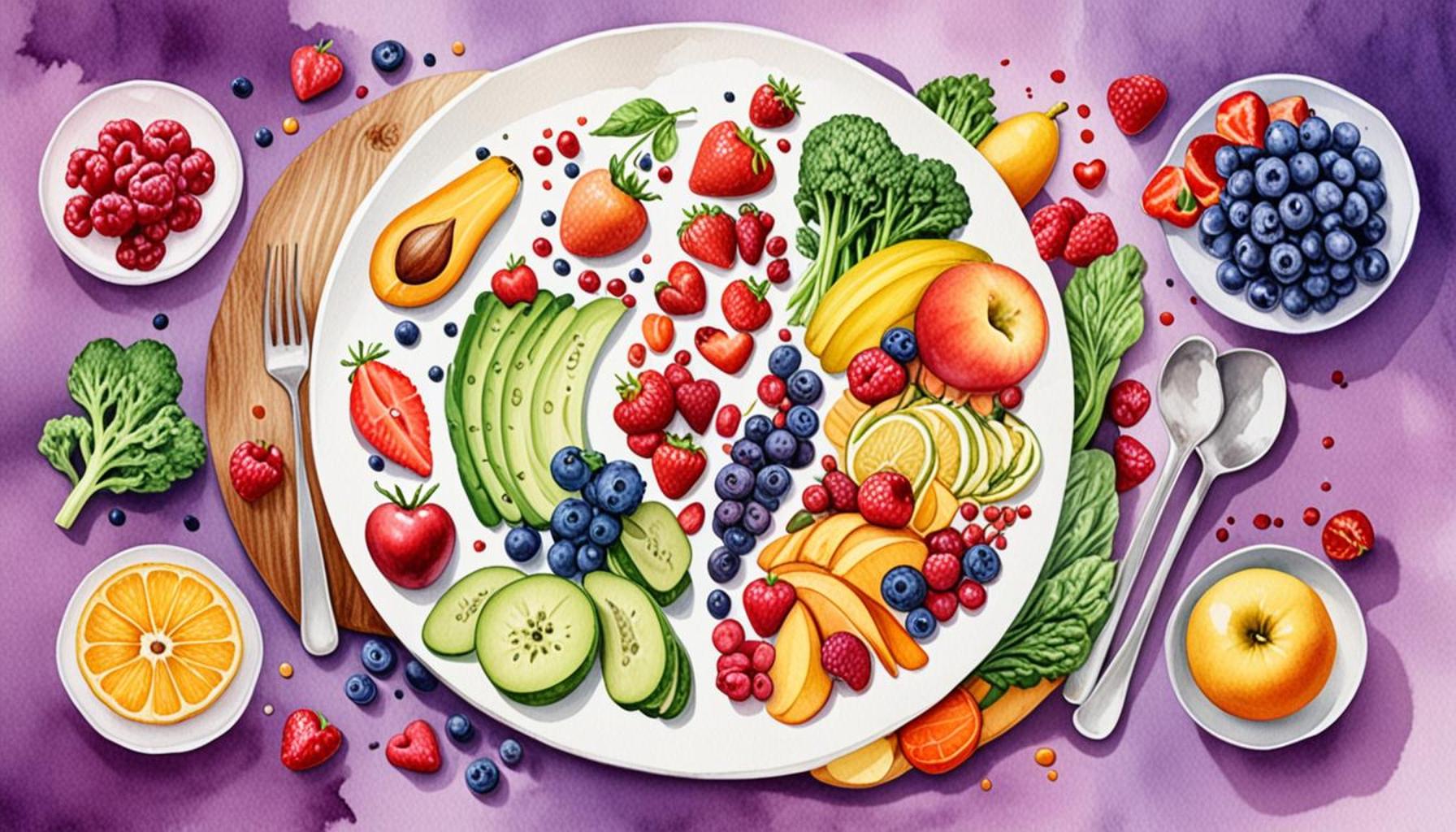Meal Planning: How to Create a Healthy and Balanced Weekly Menu

Meal Planning Made Easy
In today’s fast-paced world, meal planning has become essential for maintaining a healthy and balanced diet. With so many food choices available, it can be overwhelming to decide what to eat every day. However, a well-structured weekly menu not only eases this stress but also promotes better eating habits.
Benefits of Meal Planning
Creating a meal plan comes with numerous advantages that make it an appealing choice for many:
- Time-saving: Planning meals in advance means less time spent pondering dinner ideas each evening. By dedicating a short amount of time over the weekend to planning your week, you can streamline daily cooking into effortless tasks.
- Cost-effective: Buying groceries with a plan helps reduce impulse purchases and food waste. For instance, purchasing only the ingredients needed for planned meals prevents leftover items from spoiling and being discarded.
- Nutrition-focused: Meal planning allows you to include a variety of food groups, ensuring you meet your dietary needs. For example, incorporating fruits, vegetables, whole grains, and proteins into your weekly menus can help you achieve a well-rounded diet.
Getting Started
To embark on your journey into effective meal planning, consider the following steps:
- Assess your schedules and lifestyle to determine how many meals you need. If you have a busy work schedule, you may find that batch cooking on Sundays works best for you, ensuring you have meals ready for the week.
- Choose recipes that are both nutritious and appealing to you and your family. Websites like Pinterest and food blogs can provide a treasure trove of ideas that cater to diverse tastes and dietary requirements.
- Keep a list of favorite meals to streamline the planning process. This list can serve as a quick reference and can help you avoid decision fatigue when it’s time to plan your meals.
Moreover, consider incorporating themes for certain days of the week, such as Meatless Monday or Taco Tuesday, which can simplify the planning and inspire creativity in cooking. Sticking to these designated themes can make meal planning feel less daunting and more structured.
In this guide, we will explore various strategies to help you create a weekly menu that aligns with your personal goals, culinary preferences, and busy schedule. Dive in to discover how meal planning can transform your dining experience and turn mealtime into a joyous occasion rather than a daily chore!

DISCOVER MORE: Click here to learn about foods that affect stress
Crafting Your Weekly Menu: Step-by-Step Guide
Now that you understand the benefits of meal planning, it’s time to dive into the nitty-gritty of crafting your weekly menu. A well-thought-out meal plan will not only cater to your nutritional needs but also respect your time and budget. Here’s how to get started:
Step 1: Define Your Weekly Menu Goals
Before you begin selecting meals, take a moment to think about your goals for the week. Are you looking to eat healthier, save money, or try new recipes? Setting specific goals will guide your choices and provide a clearer vision for your meal planning. Consider the following:
- Nutritional Needs: If you or your family have specific dietary requirements, ensure you account for them when selecting meals. This may include low-carb, gluten-free, or vegetarian options.
- Portion Control: If weight management is a priority, plan for portion sizes. This can include weighing ingredients or using smaller plates to discourage overeating.
- Family Preferences: Consult your family and find out preferences and dislikes. Including everyone in the planning process can lead to more satisfied eaters and less wasted food.
Step 2: Create a Balanced Menu
With your goals clearly defined, the next step is to create a menu that reflects a balanced diet. A healthy weekly menu generally includes a variety of food groups, which contributes to overall well-being. Aim to include:
- Fruits and Vegetables: Aim for half your plate to be filled with colorful fruits and vegetables, ensuring you receive vital vitamins and minerals.
- Whole Grains: Incorporate whole grains like brown rice, quinoa, or whole grain bread to provide essential fiber and energy.
- Lean Proteins: Choose lean meats such as chicken or turkey, or plant-based options like beans and legumes to meet your protein needs.
- Dairy or Dairy Alternatives: Include dairy products or their alternatives to ensure you are getting enough calcium and vitamin D in your diet.
Additionally, consider the cooking methods you plan to use. Opt for baking, grilling, steaming, or sautéing over frying to create healthier dishes. This small change can make a significant difference in both flavor and nutritional value.
Step 3: Organize Your Shopping List
Once your menu is set, it’s essential to create a comprehensive grocery list based on the ingredients you will need for the week. Organizing this list by sections of the grocery store can save time while shopping and ensure that you won’t forget anything. Make sure to:
- Check Your Pantry: Before heading out, review what ingredients you already have at home to avoid duplicate purchases.
- Buy in Bulk: For staples like grains or canned goods, consider buying in bulk to save money in the long run.
- Shop Seasonal: Whenever possible, choose seasonal produce to get the freshest options at a lower price.
By following these steps, you can establish a solid foundation for your meal planning journey, ensuring a week filled with nutritious and enjoyable meals!
Understanding the Importance of Meal Planning
Meal planning plays a crucial role in maintaining a healthy lifestyle. By preparing your meals in advance, you not only save time during the busy workweek but also set yourself up for nutritional success. Planning your meals enables you to make conscious choices, ultimately leading to better health. Research shows that individuals who regularly engage in meal planning are more likely to stick to their dietary goals and consume a balanced diet rich in essential nutrients.
Creating Your Meal Planning System
To create a successful meal planning system, start by assessing your dietary preferences and nutritional needs. Consider incorporating a variety of foods from all food groups to ensure balanced nutrition. Begin by establishing a weekly menu that includes breakfast, lunch, dinner, and snacks. This approach allows you to strategically allocate ingredients, reducing waste and saving money.
Tools for Effective Meal Planning
Using tools such as meal planning apps, calendars, and grocery lists can enhance your meal preparation journey. These resources assist you in organizing your recipes and tracking your grocery needs efficiently. Additionally, adopting a flexible mindset is beneficial; don’t hesitate to swap meals around based on seasonal ingredients or sales at your local grocery store. Remember, the key to a successful meal planning routine lies in consistency and adaptability. As you find your rhythm, you will uncover new flavors and ingredients, bringing excitement to your weekly meals.
| Category | Benefits |
|---|---|
| Time Management | Reduces daily cooking time and stress. |
| Healthier Choices | Encourages the inclusion of fresh, nutritious ingredients. |
| Cost-Effective | Limits impulse buys and reduces food waste. |
Incorporating meal planning into your weekly routine can make a significant difference in your lifestyle. By understanding the benefits and utilizing effective tools, you can craft a healthier and more balanced weekly menu that caters to your unique needs. The journey towards better eating habits starts with a well-thought-out plan!
DIVE DEEPER: Click here to discover how exercise can enhance your sleep
Maximizing Your Meal Prep and Cooking Efficiency
Once your menu and shopping list are ready, the final steps involve meal prep and cooking. Efficient meal preparation allows you to stick to your meal plan and saves you precious time during busy weeknights. Here are some strategies to enhance your cooking efficiency:
Step 4: Meal Prep Techniques
Investing a few hours on the weekend can set you up for a week of nutritious meals that are quick and easy to assemble. Consider the following meal prep techniques:
- Batch Cooking: Prepare larger quantities of dishes like soups, casseroles, or stews. Store them in individual containers to have wholesome meals ready to go. Not only does this save time, but it can also save money by reducing food waste.
- Prepping Ingredients: Chop, slice, and store vegetables in advance. You can also cook grains in bulk and freeze portions for later use. This way, assembling a meal becomes a simple task of tossing ingredients together.
- Utilizing Freezer-Friendly Meals: Create meals that can be frozen ahead of time. Dishes such as chili, curry, or pasta sauces freeze exceptionally well, allowing you to easily rotate leftovers and avoid monotony in your menu.
Step 5: Time-Saving Cooking Techniques
Efficient cooking techniques can drastically reduce the time you spend in the kitchen throughout the week. Here are a few methods to consider:
- One-Pan Cooking: Embrace the simplicity of one-pan meals, which not only minimize clean-up but also allow for balancing flavors. For instance, tossing protein, veggies, and seasoning onto a single sheet pan is both flavorful and efficient.
- Slow Cookers and Instant Pots: Invest in appliances that can do the heavy lifting for you. Slow cookers can help you create tender and flavorful meals with minimal effort, while an Instant Pot can pressure-cook meals in a fraction of the time.
- Quick Cooking Grains: Choose quick-cooking grains such as couscous or bulgur, which can be ready in 10 minutes or less, providing a nutritious base for meals without a lengthy cooking time.
Step 6: Keeping Variety in Your Meals
To keep your meals interesting, introduce variety in flavors and textures. Eating the same meals can lead to boredom and decrease your motivation to maintain a meal plan. Here are some strategies to consider:
- Themed Nights: Implement themes, such as “Taco Tuesday” or “Meatless Monday,” which can help simplify decision-making while exciting your palate. These themes can also encourage you to try new recipes within that specific genre.
- Exploring Global Cuisines: Don’t hesitate to explore different international cuisines. Adding diverse spices, herbs, and flavors from around the world can transform simple ingredients into exotic meals.
- Mix and Match: Think of your meals as building blocks. Use the same base ingredients but change sauces, spices, or cooking methods to create completely new dishes. For instance, roasted vegetables can be paired with a tahini dressing one night and tossed into a stir-fry the next.
Incorporating these additional steps into your meal planning journey can help streamline both your cooking and grocery shopping experiences. This way, you will not only enjoy the benefits of a balanced menu but also maintain the excitement of culinary variety throughout the week.
DISCOVER: Click here to learn how exercise can boost your mental well-being</a
Conclusion
In summary, meal planning serves as a vital tool for crafting a healthy and balanced weekly menu, enhancing not just your dietary habits but also your overall well-being. By investing time in creating a thoughtful plan, you empower yourself to make nutritious choices, thereby reducing reliance on processed options that often lead to poor eating habits. From strategic grocery shopping to effective meal prep techniques, each step plays a significant role in achieving your health goals.
Moreover, incorporating variety and excitement into your meals is key for maintaining motivation. Embracing themes, experimenting with global cuisines, and utilizing creative cooking techniques can transform routine meal preparation into a delightful experience. By approaching your meals as an opportunity to explore and innovate, you will find it easier to stick to your planned diet, ensuring long-term success in maintaining a healthy lifestyle.
In the fast-paced world of today, efficiency is essential. Implementing time-saving methods—like batch cooking, maximizing the use of meal prep tools, and enjoying one-pan dishes—will not only help you save time but also elevate the quality of your meals. Ultimately, the journey to healthier eating through effective meal planning is both a practical and enjoyable one.
As you embark on your meal planning adventure, take the time to experiment, learn, and adjust your strategies over time. The positive impacts on your health, wallet, and overall lifestyle will be well worth the effort. Don’t hesitate to share your experiences and delve deeper into the art of meal planning—it’s a pathway to a more satisfying and nourishing dining experience.


